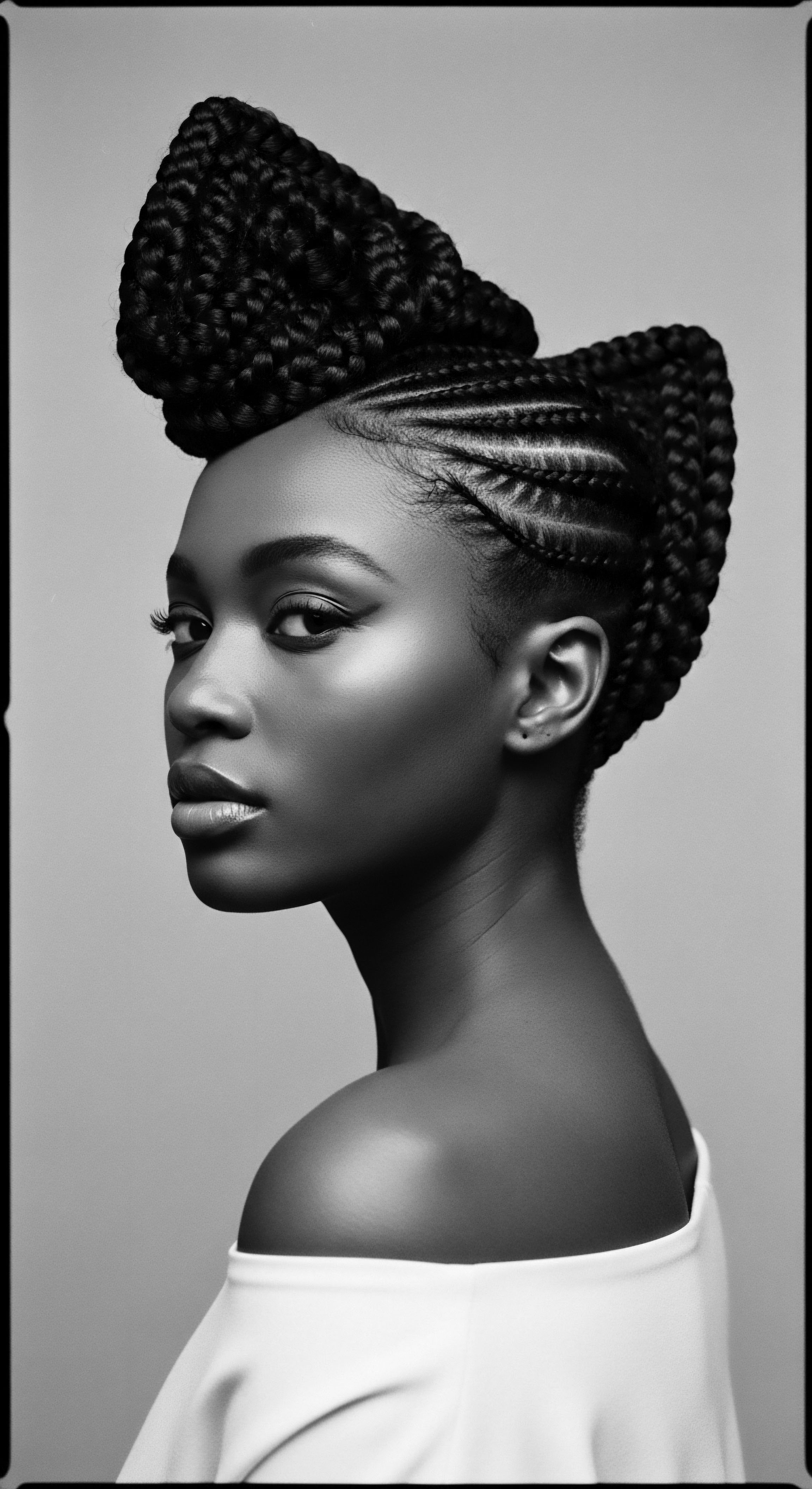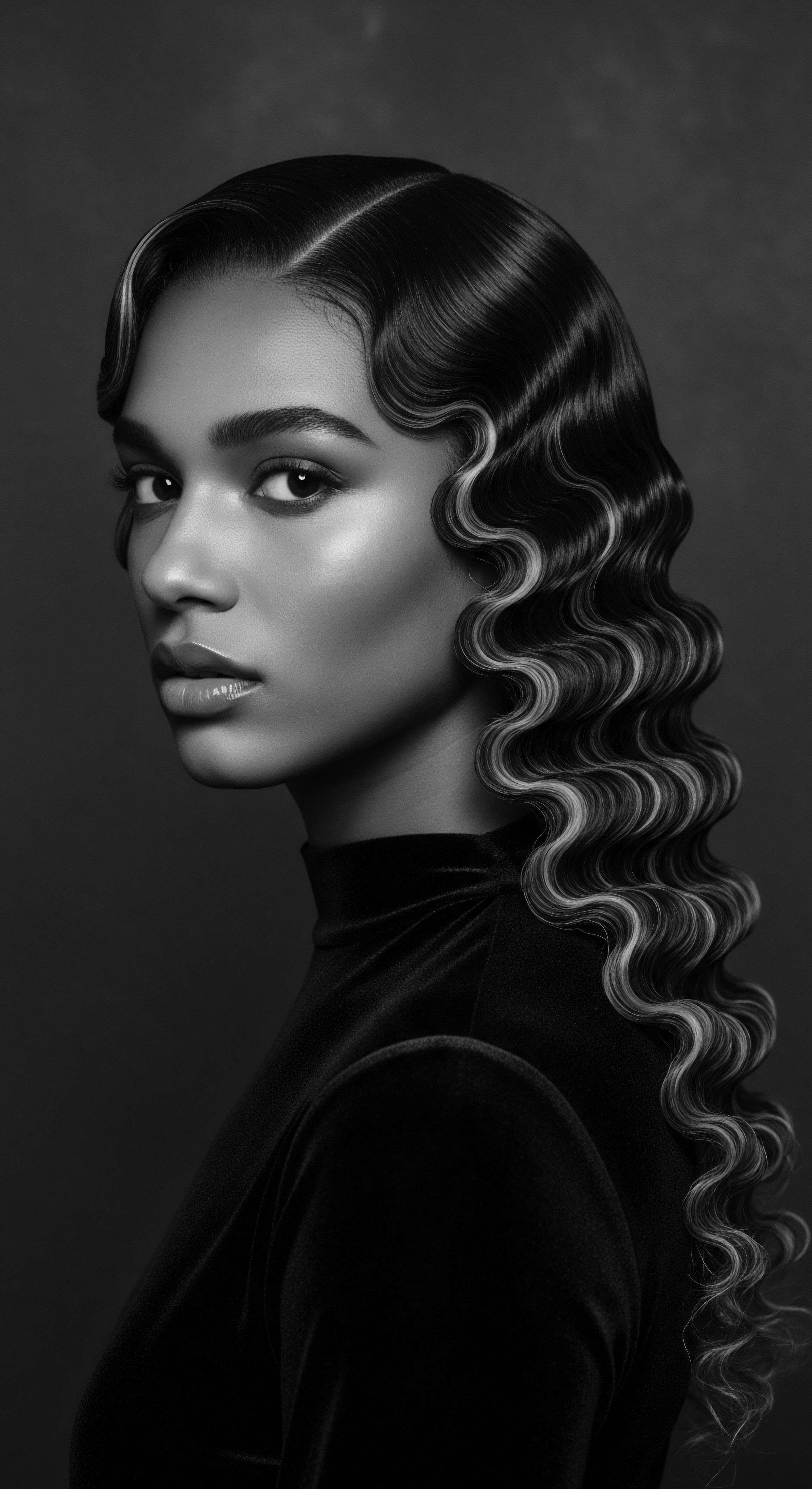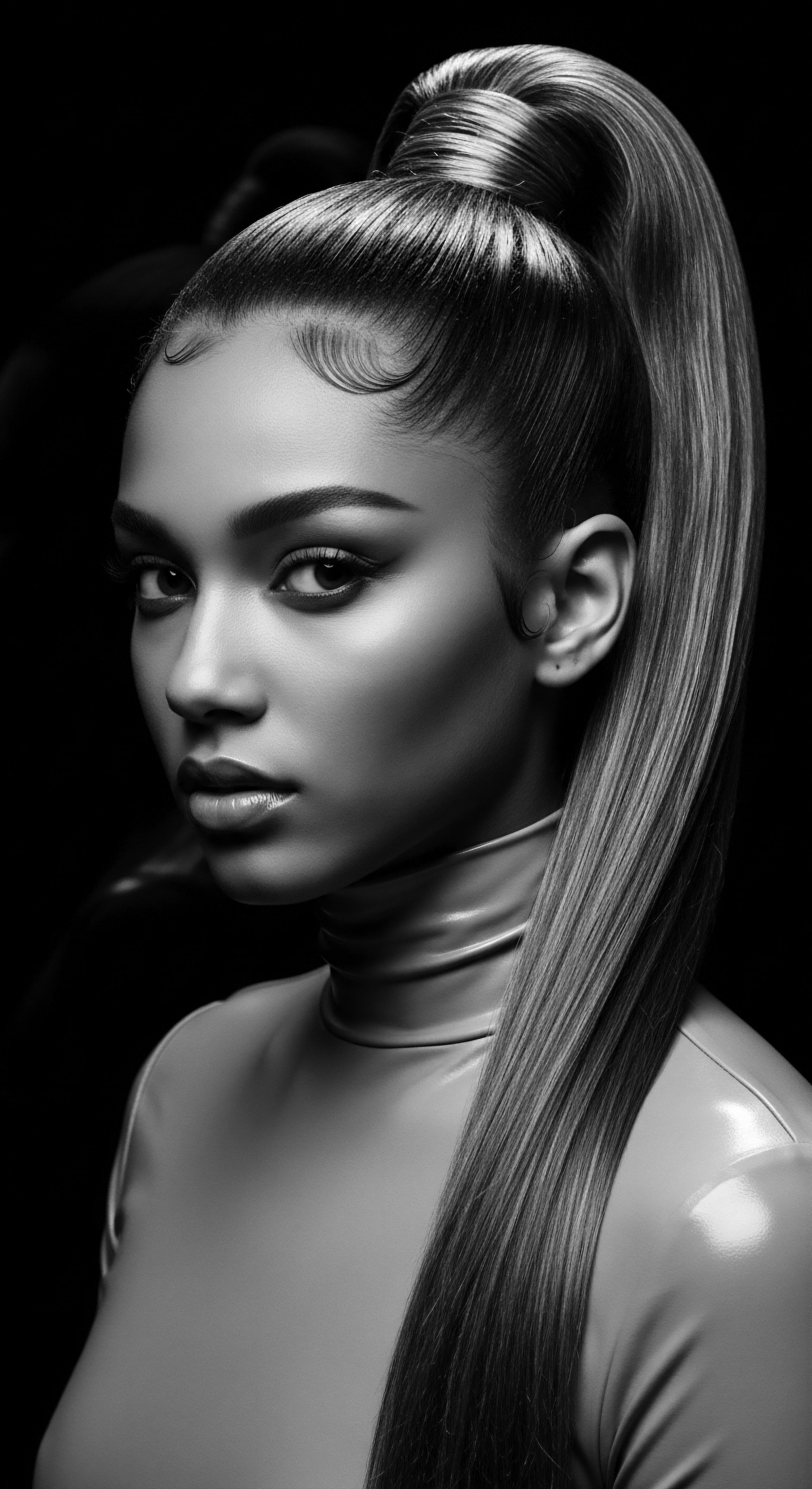
Roots
Consider for a moment the very fibers that spring from your scalp. For those of us with coils, kinks, and waves, these strands are far more than mere protein filaments; they are whispers from antiquity, resilient carriers of memory, and tangible testaments to journeys spanning continents and centuries. Our hair, truly, is a living, breathing archive , each curl a testament to an ancestral narrative, a deep connection to the rich soil of our beginnings. It is within this understanding that the inquiry into how historical hair practices inform today’s textured hair care transforms from a simple question of technique to a soulful meditation on heritage.
The very structure of textured hair, often marvelously coiling and zig-zagging, holds secrets passed down through millennia. From an elemental biological perspective, the elliptical cross-section of the hair shaft and the unique arrangement of keratin fibers contribute to its distinctive texture, its innate volume, and its sometimes delicate nature. This inherent structure, a gift of evolution, required specific modes of care, modes that our ancestors intuitively grasped long before microscopes revealed the intricate details of the follicular landscape. Their wisdom, born of intimate observation and necessity, laid the groundwork for practices we now rediscover, often validated by modern trichology.
The intrinsic structure of textured hair, a biological marvel, necessitated and inspired ancient care practices, forming the earliest roots of hair heritage.

Echoes from the Source
The understanding of textured hair begins with its fundamental make-up, a genetic symphony orchestrated over countless generations. Picture the hair shaft itself, not as a straight column, but as a gently winding or tightly coiled helix. This geometry influences everything from moisture retention to light reflection, and crucially, how fragile or resilient a strand might be. Our forebears, without formal scientific classification systems, knew this intimately.
They understood their hair behaved differently based on its “spirit,” its natural tendency to absorb or repel moisture, its ability to retain styles. Their lexicon, though unwritten in textbooks, spoke to the varied expressions of textured hair.
Take, for example, the concept of hair types. While modern systems like the Andre Walker typing chart attempt to categorize curls and kinks by numerical and alphabetical designations, ancient African societies possessed their own, often more poetic and nuanced, ways of distinguishing hair. These informal classifications were less about strict categorization and more about understanding the hair’s unique temperament and needs.
A woman might speak of hair that “drinks deeply” of water or hair that “holds its shape like a coiled serpent,” reflecting an experiential wisdom that predates scientific nomenclature. This ancestral understanding, rooted in observation and community knowledge, is the true foundation upon which all subsequent textured hair care rests.
The rhythmic cycle of hair growth, too, was observed and honored. Our ancestors understood that hair had periods of growth, rest, and shedding. Their practices often aligned with these natural rhythms, focusing on gentle handling during periods of vulnerability and celebrating robust growth. This cyclical understanding often informed spiritual rituals and seasonal grooming habits.
The very factors influencing hair health, from diet to environment, were instinctively managed. Communities living near nutrient-rich rivers or lush forests often incorporated local botanicals into their regimens, demonstrating an early, sophisticated form of nutritional trichology .

Ancestral Wisdom in Hair Anatomy?
How did pre-colonial societies grasp the intricate anatomy of textured hair without scientific instruments? Their knowledge was experiential, passed through generations of observation and practice. They discerned the fragility of certain curl patterns, the tendency of coils to shrink upon drying, and the need for specific emollients to maintain pliability.
This hands-on, generational wisdom of hair was a form of empirical science, long before the term existed. It led to the development of methods that minimize breakage, retain moisture, and protect the hair from environmental stressors – precisely what modern science validates as essential for textured hair health.
- Shea Butter ❉ Used across West Africa for centuries, its rich emollient properties deeply condition hair and scalp, mirroring its modern application for moisture.
- Black Soap ❉ Originating from West Africa, often used for cleansing, its gentle, plant-based lather cleanses without stripping natural oils, a parallel to today’s sulfate-free cleansers.
- Chebe Powder ❉ From Chad, traditionally mixed with oils for hair masks, known to strengthen strands and aid length retention, aligning with contemporary protein treatments.
The very tools employed centuries ago were also a testament to this understanding. Combs carved from wood or bone, designed with wide teeth, speak to an intuitive grasp of minimizing friction and preserving the curl pattern. These were not random implements; they were purpose-crafted instruments , each curve and tine a deliberate choice to honor the hair’s inherent nature. This ancestral ingenuity in tool design directly informs the ergonomic and material choices of today’s textured hair tools, from wide-tooth combs to detangling brushes.

Ritual
The transition from foundational understanding to consistent application moves us into the realm of ritual. Hair care, throughout history, has rarely been a solitary, pragmatic chore. For Black and mixed-race communities, it has always been a profound ritual, an act interwoven with identity, community, and resistance. These historical rituals, far from being mere vanity, served as powerful acts of self-preservation and cultural continuity, their legacy indelibly etched into how textured hair is cared for today.
Across various African societies, hair styling was an elaborate art form, often taking hours, even days, to complete. This extended time was not just for aesthetic appeal; it was a period of communal bonding, storytelling, and the transmission of knowledge. Grandmothers, mothers, and aunties would impart wisdom, history, and life lessons while their hands deftly worked through kinks and coils. This generational transfer of knowledge, often through touch and oral tradition, forms the very core of textured hair heritage.
The practice of hair braiding, for instance, became a symbol of social status, tribal affiliation, and even spiritual beliefs. Specific patterns communicated marital status, age, or readiness for certain life rites.
Historical hair rituals transcend mere grooming; they are acts of communal bonding, identity affirmation, and cultural knowledge transfer.

The Art of Protection
One of the most profound influences of historical practices on contemporary textured hair care lies in the widespread adoption and evolution of protective styling. From ancient Egyptian plaits to elaborate West African cornrows, these styles served a dual purpose ❉ aesthetic beauty and hair preservation. They guarded the delicate strands from environmental damage, minimized manipulation, and promoted length retention.
Consider the cornrow , a style with origins tracing back to ancient Africa, where it often signified social standing, tribe, or religious devotion. During the transatlantic slave trade, cornrows took on a new, urgent significance. Enslaved Africans, forcibly stripped of their material culture and denied traditional grooming tools, continued to braid their hair, often in secret. These intricate patterns were not just a defiance of erasure; they sometimes served as concealed maps for escape routes, or even, as famously recounted, carried rice grains and seeds woven into the braids to plant in new, hostile lands (Byrd & Tharps, 2001, p.
25). This powerful historical example perfectly illustrates how hair practices were not just about aesthetics, but about survival, resistance, and the continuity of ancestral knowledge. The modern protective styles we see today—box braids, twists, dreadlocks, weaves—are direct descendants of these ancestral practices, carrying forward their protective function and their profound legacy of resilience.
| Historical Practice Ancestral Hair Oiling with plant-based emollients (e.g. palm oil, shea butter) to condition and seal moisture. |
| Contemporary Parallel Modern Leave-in Conditioners and Hair Oils utilizing botanical extracts and nourishing fatty acids to hydrate and protect. |
| Historical Practice Communal Braiding Sessions as social gatherings, knowledge transfer, and time for intricate protective styles. |
| Contemporary Parallel Natural Hair Salons and Meet-ups fostering community, shared expertise, and appreciation for varied textured hair styles. |
| Historical Practice Use of Wide-tooth Combs carved from natural materials to gently detangle hair and preserve curl patterns. |
| Contemporary Parallel Wide-tooth Detangling Combs and Brushes designed with flexible bristles and broad spacing to minimize breakage on wet or dry textured hair. |
| Historical Practice The enduring spirit of ancestral care continues to shape and inform the innovations in textured hair regimens today. |

Tools and Transformations Through Time
The tools themselves evolved, though their core purpose remained constant. From simple, handcrafted combs and picks fashioned from natural elements like wood, bone, or horn, we trace a direct lineage to today’s meticulously designed detangling brushes and picks. Early tools were often imbued with spiritual significance or artistic embellishment, serving as personal adornments themselves. Their utility went beyond mere styling; they were instruments of care, designed to navigate the unique properties of textured hair with reverence.
The concept of hair transformation, too, has deep historical roots. While chemical relaxers are a relatively modern invention, the desire to alter or manipulate hair texture, whether for practical or aesthetic reasons, is not new. Historical methods might have involved natural ingredients to temporarily soften or straighten coils, often for ceremonial purposes or to achieve specific looks that conveyed status. This long history of manipulation, from gentle alterations to more drastic changes, reflects a continuous interplay between personal expression, cultural standards, and the possibilities offered by available resources.

How Did Traditional Hair Artistry Influence Current Styling?
Traditional hair artistry directly influenced current styling by establishing the foundational techniques and principles that prioritize hair health and longevity. The intricate braiding, twisting, and coiling methods, which minimized stress on the hair shaft and scalp, are now recognized as essential “low manipulation” strategies. The emphasis on moisturizing and sealing with natural oils before styling, prevalent in many ancestral practices, is directly mirrored in the modern “LOC” (Liquid, Oil, Cream) method or similar moisture-retention regimens for textured hair. This historical emphasis on gentle, protective approaches provided a timeless blueprint for caring for fragile, textured strands.

Relay
The journey of textured hair care from ancient practices to contemporary regimens is not a linear progression but a complex relay, a handing off of wisdom, sometimes interrupted, sometimes reclaimed, but always persistent. This persistence is most apparent in the modern natural hair movement, which, at its heart, is a powerful act of heritage reclamation, a conscious decision to connect with and honor ancestral modes of being.
Modern science now often provides the “why” behind the “what” of traditional practices. The efficacy of ancient hair oiling, for example, once understood through empirical observation, is now explained by lipid science ❉ certain oils penetrate the hair shaft, reducing hygral fatigue and strengthening the strand. Similarly, the protective benefits of braids and twists, long known for preserving length and preventing breakage, are now understood through the lens of minimizing mechanical stress and environmental exposure. This intersection of ancestral wisdom and scientific validation strengthens the cultural authority of these practices, moving them beyond anecdotal belief into evidenced efficacy.
The contemporary natural hair movement stands as a powerful testament to heritage reclamation, weaving ancestral practices with modern scientific understanding.

The Natural Hair Movement’s Deep Roots
The resurgence of the natural hair movement in recent decades is more than a fleeting trend; it is a profound cultural statement. It represents a conscious decision by many Black and mixed-race individuals to reject Eurocentric beauty standards that historically marginalized textured hair. This movement directly draws from the wellspring of historical practices, advocating for styles like cornrows, Bantu knots, and twists that were once symbols of oppression or otherness.
By embracing these styles, individuals are not just making a fashion choice; they are making a declaration of identity , a tangible connection to their heritage. This reclamation extends to ingredients as well, with a renewed interest in traditional African botanicals such as shea butter, coconut oil, and argan oil, all used historically for their nourishing properties.
The movement has also driven significant innovation within the beauty industry. Historically, mainstream hair care products often overlooked the specific needs of textured hair, leading to a reliance on harsh chemicals for straightening. The natural hair movement, fueled by consumer demand for products that support healthy, natural hair, has spurred the creation of dedicated lines, often featuring ingredients and formulations that echo ancestral remedies. This dynamic interplay between consumer advocacy, historical knowledge, and scientific development shapes the current landscape of textured hair care.

Are Today’s Hair Tools Echoes of the Past?
Many contemporary textured hair tools are indeed echoes of the past, albeit refined through modern materials and ergonomic design. The wide-tooth comb, essential for detangling textured hair without causing undue breakage, directly parallels the hand-carved wooden and bone combs used by ancient African societies. These early tools were engineered to gently separate curls, respecting the hair’s coiled structure.
Similarly, the concept of hair picks, designed to lift and shape voluminous textures, reflects the historical use of similar implements to style and adorn intricate updos. While materials have changed from wood to plastic or specialized metals, the fundamental principles of gentle manipulation and curl preservation, inherited from ancestral ingenuity, remain central to their design and purpose.

Beyond the Strand Holistic Wellness
The relay of historical practices also extends to the holistic dimension of hair care. Ancestral wisdom consistently viewed hair not in isolation, but as an integral part of overall well-being. Hair care rituals were often accompanied by practices that nourished the body, mind, and spirit. This holistic approach recognized the interconnectedness of internal health and external appearance.
- Dietary Practices ❉ Traditional African diets rich in nutrient-dense foods (leafy greens, root vegetables, lean proteins) supported hair growth and strength from within.
- Herbal Remedies ❉ Knowledge of local herbs extended to treatments for scalp conditions and hair vitality, linking directly to modern “clean beauty” and natural ingredient focus.
- Mindful Grooming ❉ The slow, deliberate nature of historical hair rituals fostered patience and self-care, a stark contrast to hurried modern routines, inviting a return to intentionality.
This enduring legacy informs the modern emphasis on holistic hair health, encouraging individuals to consider nutrition, stress levels, and even spiritual connection as vital components of a comprehensive hair care regimen. It is a powerful reminder that true radiance emanates from a place of inner harmony, a philosophy deeply rooted in the ancestral wisdom of our forebears.

Reflection
To truly understand how historical hair practices guide today’s textured hair care is to stand on the shoulders of giants, drawing from the boundless well of ancestral wisdom. Our strands are not merely organic fibers; they are living testaments to enduring heritage, resilience, and boundless creativity. Each coil and curl holds a memory, a story of survival, artistry, and profound connection to something larger than ourselves. From the earliest communal gatherings for braiding under ancient skies to the quiet moments of self-care in modern homes, the thread remains unbroken.
This ongoing journey, this living archive we call Roothea, seeks to honor that lineage. It is a gentle reminder that every detangling session, every nourishing application of oil, every protective style chosen is an act of continuing a legacy. It is a dialogue between the past and the present, a profound affirmation of identity that echoes through generations. May we continue to listen closely to these whispers, allowing the soul of each strand to guide us toward a future where textured hair is celebrated universally, its rich heritage forever acknowledged.

References
- Byrd, A. D. & Tharps, L. L. (2001). Hair Story ❉ Untangling the Roots of Black Hair in America. St. Martin’s Press.
- Roberts, S. (1996). African-American Hair ❉ A Reflection of Culture and Identity. In D. A. Williams (Ed.), Black Culture and History ❉ Studies in Communication. State University of New York Press.
- Sweet, K. (2007). The Hair Story ❉ A Cultural History of Hair from Ancient Africa to the Modern Age. Routledge.
- Patton, M. M. (2006). Hair-Raising ❉ African American Women’s Hair and Culture. Rutgers University Press.
- Mercer, K. (1994). Welcome to the Jungle ❉ Identity and Difference in Black British Culture. Routledge.
- Wilkins, M. (2007). The Art of Hair ❉ The Ultimate Guide to Braids, Locs, and Twists. Amistad.
